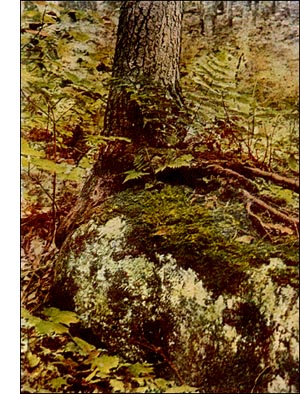Genus Mnium
 Genus MNIUM, Linn.
Genus MNIUM, Linn.The species of the Genus Mnium are handsome mosses, usually tall and robust, with large, translucent leaves. They may be looked for about the bases of trees, on lawns, along roadsides, and in damp woods. They are especially attractive on the banks of mountain brooks or in the cool water of bubbling springs.
The beginner may recognise some members of the genus by the dainty rosettes on the summits of the male plants, each rosette made of pale-green leaves with a beaded centre of darker green. Some species have the fertile stems erect with branches growing from near their bases or from creeping stems. The branches are often different from the main stems, being fernlike, prostrate, or curved with rooting tips so as to form successions of miniature arches.
The great Swedish botanist, Carolus Linnaeus, named the group from the Greek for; an ancient word for "moss."
The leaves of all the Mniums are dainty and fresh and their cell-structure and their colour are so delicate that it will repay one to examine them with a hand lens or the low power of a compound microscope. The leaves are usually large, rounded, more or less elliptic or tongue-shaped; the margin usually has a distinct border and is frequently spiny toothed; the vein either vanishes below or extends beyond the apex; the cells are smooth, rounded-hexagonal or rarely elongated.
The spore-cases are more or less pendulous, on long and slender, often clustered pedicels. They are oblong-cylindrical or oval, never pear-shaped. The lids are convex, long-beaked, taper-pointed, or tipped with a tiny blunt point. The annulus is usually conspicuous, rolling back as the lid falls.
The peristome is double, the outer teeth being long and narrow or lance-shaped, closely cross-barred below, with the bars evident on the inner surface; the inner membrane is keeled and reaches to the middle of the outer teeth, where it divides into large segments alternating with two or three thread-like segments (cilia). Sometimes the cilia have spurs attached at intervals to the margins.
There are ninety-nine species in all, thirty-three in North America. Of the fifteen species which appear in the Eastern States, five will be found with entire borders to the leaves, five with a single row of teeth, and five with a double row.
Dotted Mnium Moss
Mnium Affine Moss
Mnium Hornum Moss
Mnium Punctatum Moss
Pointed Mnium Moss